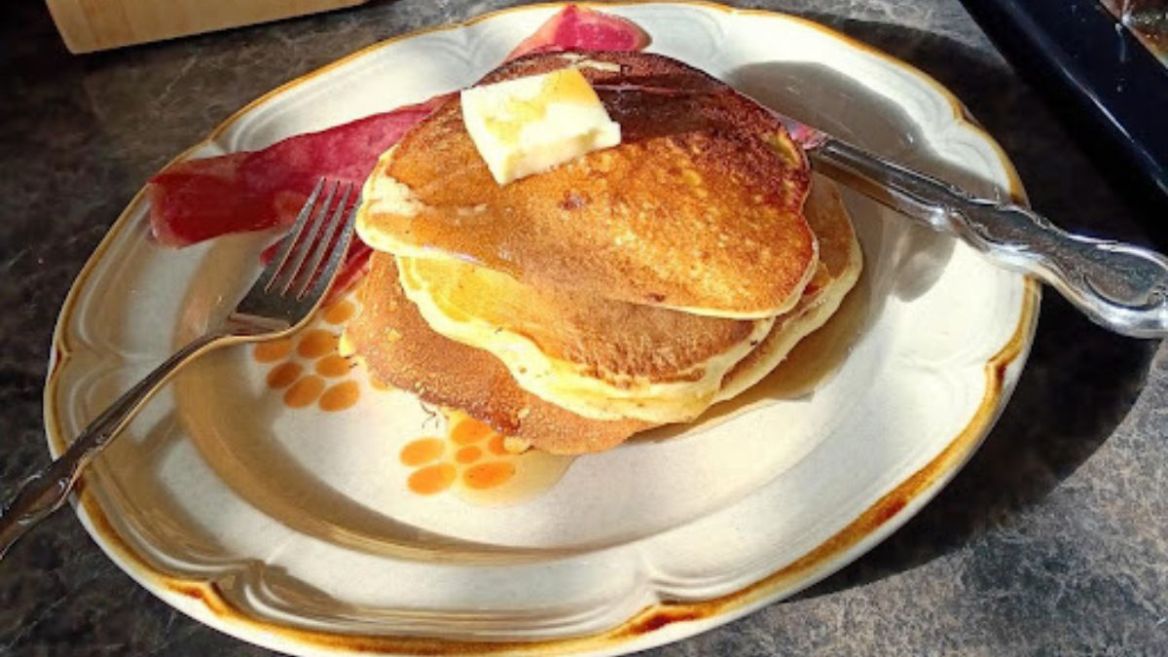Baking Mix Ingredients: Adjust accordingly if you are making a double batch or more.
- 2 C all-purpose flour (For extra fiber, use ½ C of whole wheat flour with 1 ½ ap flour or combo of your choice.)
- 1 T baking powder
- 1 tsp salt
- 4-5 T butter, vegetable oil, shortening or lard
Instructions:
- Sift flour into a bowl.
- Add baking powder and salt and whisk or stir to combine well
- Mix in shortening with a pastry blender, with 2 forks or with your fingers. Mixing all the ingredients in a food processor is the most efficient way to make this mix, if you have a food processor.
- Because there are no ingredients to keep this shelf stable at the store or in your pantry, store the mix in a sealed jar or other airtight container in the fridge for up to 2 or 3 months. You could start by making a double batch and store half in a pint jar. This is just enough for your next batch of pancakes or garlic cheddar biscuits!
Instructions For Baking Mix Pancakes:
- Preheat a non-stick skillet or griddle on medium heat.
- In a large bowl, combine 2 C baking mix and 1 tsp baking soda.
- Stir 1 3/4 C milk or buttermilk and 1 beaten egg into the dry ingredients.
- Measure about 1/4 C of the batter onto a heated pan or griddle that has been coated with shortening such as vegetable oil spray or butter.
- Cook until bubbles appear on the top of each pancake and the edges begin to turn golden brown.
- Gently flip each pancake and cook until golden brown.
- Serve with butter or margarine, real maple syrup, jam or the topping of your choice. See Variations below.
Variations: For fancier pancakes, add toppings like berries, cooked and drained bacon pieces, mini-chocolate chips, pieces of apple, pear or bananas. You can even sprinkle them on the top of each pancake before you flip! For Easter breakfast or brunch, imagine serving fancy Lemon Poppyseed Pancakes with the addition of some lemon juice, zest, sugar or honey and poppy seeds!
Substitutions: For buttermilk: Add about a 1 tsp of lemon juice to regular milk and let it sit for a few minutes which adds the tang of buttermilk. To substitute the egg in this recipe or in other baking, check out these tips for using flax seed meal instead!
Uses for this Baking mix include: breakfast foods like pancakes, waffles, egg bake, plain or garlic cheddar biscuits. Click on this link to get recipes from Betty Crocker herself, whose company came up with one of the first baking mixes to hit the market in the 1940’s. It’s known as Bisquick! She helped make General Mills the giant it is!
A Story of Breakfast Foods From Scratch or Ultra-Processed:
Many of our great-grandmothers (or grands) mostly cooked from scratch. Generations of cooks in the 50’s and later began to use convenience foods like pancake mix or the popular baking mix known as Bisquick endorsed by General Mills Sweetheart Betty Crocker. The General Mills website describes Betty’s history and huge popularity over the last century! At the end of last year General Mills was the 6th largest food or beverage company in the U.S. and Canada. Click here to see others on the list.
These mixes were great profit-makers and highly advertised to post WWII homemakers as modern, inexpensive, easy ways to get a meal on the table quickly. Kitchen work was described as drudgery primarily delegated to women (it can be!) rather than joyful and from-scratch cooking waned. Profits, farms and stores grew larger. The race began for a place on the shelves for foods often described today as "ultra-processed".
In the food system, "ultra-processed” means different things to consumers, small and large-scale farmers, nutrition experts and food processing corporations. A simple description of "ultra-processed" foods is: a food product with more than 5 ingredients, many of which are unpronounceable words for flavorings, colors, stabilizers and preservatives that our grandparents would not recognize as food. For example, the ingredients list on most freshly baked bread is relatively short, but that bread does not last as long on the truck, the shelf, or in your home as does ultra processed bread with more additives.
Invitation: Consider balancing convenience with just one simple food preparation. Develop a new habit, especially during this Lenten journey. Try the Baking Mix recipe above for pancakes and other breakfast foods. Or make your own Granola where you control the ingredients; Hot Oatmeal with Fancy Toppings as suggested above. Try homemade Pasta Sauce, Salad Dressing, Croutons, or Cookies, maybe Bread or Pizza. With some time, effort and a few pantry staples, shoppers and cooks can skip dozens of processed options on grocery store shelves. Join with a friend and discover more joy in the kitchen, more health for people and planet.





Post a Comment